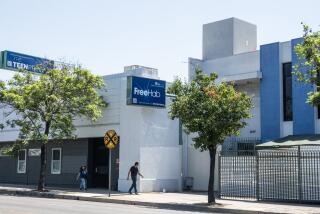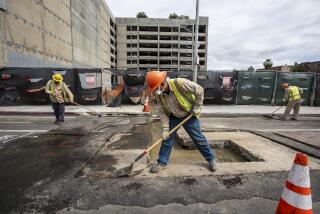Friends Under the Skin
SUN VALLEY — The white supremacy symbols and black power emblems tattooed into the bodies of Dayvid Franke and Aundre Omar tell tales of the lives they left behind, and of the anger which brought them together.
A year ago, Franke says, he was hanging out with skinheads, robbing and stealing in the San Fernando Valley to support his cocaine addiction. Omar recalls sleeping in a cardboard box on Skid Row, bouncing in and out of missions, dealing drugs and getting high off a crack pipe.
When both finally cried out for help, they were drawn to an oasis in Sun Valley--a drug recovery center for men called People in Progress. They came hoping to find sobriety, but they found in each other something unexpected--understanding and friendship.
“I remember walking in there and seeing all these white people,” said Omar. “Dayvid was sitting there reading a book on Nazis. We looked at each other. We argued, fought and almost killed each other.”
But one day, Omar said something Franke will never forget.
“Aundre told me, ‘Hey, I understand all that anger and pain you have inside, ‘cause I have it too,’ ” Franke recalled. “He was right. I didn’t hate black people. I hated everybody. I hated myself.”
When men commit themselves to six months of sober living at People in Progress, many of them say miracles happen. It is a controlled chaos where addicts enter a shelter stripped of the prejudices rife on the outside. It is an arena where men butt heads because of fear, then bond because of purpose. It is a house where the desire and need for recovery can allow men to transcend issues of race.
“Two people like me and Aundre would have never become friends if it weren’t for this house,” said Franke.
Located in the back lot of a mini-mall on Sunland Boulevard, People in Progress quietly opened its doors in the summer of 1990. Since 1974, PIP had already been making inroads in drug and alcohol rehabilitation at its main office in the Westlake neighborhood near downtown. As the scourge of drugs spread outside Los Angeles, the need for a satellite center led to the creation of the Sun Valley location, the county’s first residential recovery center in the San Fernando Valley.
Operating today on shoestring budget of $203,000 in county funds and about $50,000 in private contributions, the 84-bed residence provides a temporary home for addicts, complete with recovery education, counseling and job placement after residents have graduated to sobriety. PIP also doubles as a 24-hour haven for the homeless, offering food, clothing and drop-in drug and alcoholic counseling services.
By the time drug abusers arrive at the door, they have hit rock bottom. After spiraling down a path of self-destruction that took him from Los Angeles to Utah and back, Franke voluntarily checked in. Omar, on the other hand, needed a guide.
*
Standing side by side, Omar and Franke are yin and yang. Omar, 31, is built solid, like a box. He’s a gentle giant, a soft-spoken man with a raspy voice. Most of his tattoos celebrate his South-Central roots and black pride.
Franke, 26, is lean and energetic, almost hyperactive. In mile-a-minute staccato speech, he spits out his observations on religion and philosophy, mixing curse-filled street slang with eloquent quotations from Dr. Martin Luther King. He also is covered with tattoos, some commemorating acts of his skinhead past.
The men couldn’t be more different--or, oddly enough, alike.
For Omar, his descent into drugs and alcohol began when he was a boy. Dealing with reality in South-Central became difficult for him at the age of 8 when his mother died. Drinking beer and smoking weed made him feel good.
But by the time he entered Long Beach Polytechnic High School, Omar needed to feel that good every day. Although playing football brought him superstar status, he was inwardly ashamed and depressed because he could barely read and write. He was graduated anyway. After he left school in 1983, Omar was too afraid to admit to anyone that he was functionally illiterate, so he kept using.
“I started running with gangs, selling drugs, stealing from my family,” Omar said. “I burned all my bridges, and there was nowhere to turn but the streets.”
He bounced from the streets, to prison, to recovery programs--and then back to the streets--in a punishing, withering circle. The once bulky, broad-shouldered athlete had dropped to a 169-pound shell of his 200-plus former self. Then, he found an angel named Bella.
“I met her at church, and this is what she does, picks people up off the streets. She brought me to the Valley, which was good ‘cause it was away from L.A.”
While Omar was on Skid Row, Franke was in North Hollywood living a parallel life. His introduction to drugs came from a relative, a telling example of a dysfunctional family life. At 12, he was smoking pot. By 15, he was turned on to “crank.” And then, like Omar, he joined a gang and started robbing people and dealing drugs. Looking for acceptance from “shot callers” in the gang landed him in jail for attempted murder.
“I can’t believe I did those things,” he said. “We would get high and see who could screw people up the worst without killing them. I cut a guy’s voice box out.”
Finally, on May 25, 1995, after much goading from his mother and wife, Franke checked into PIP.
When Franke and Omar met, cultures clashed, to say the least. Fights between the two over which was the superior race became a daily event in the TV room. Then, Omar called a truce.
“One day, during morning meditation, Dayvid was sharing his thoughts on blacks. I told him we needed to put our differences aside and focus on recovery,” Omar recalled. “That’s when we got close and realized, we’re just alike.”
Franke agreed.
“Me and Aundre and everybody in this house, we’re all the same, just people suffering,” he said.
Richard Westbrook, PIP program coordinator, works closely with addicts like Omar and Franke as they overcome their addiction. For many in the house, Westbrook is PIP’s heart and soul, and they credit him more than anyone else for their newfound sobriety. But Westbrook says the strength is hidden inside each addict, waiting to be drawn out.
“Take Aundre. He’s interesting, intelligent and has great leadership skills. But ironically it’s the rational defenses that keep an addict loaded,” Westbrook said. “Those defenses are the same ones we need to survive.”
Part of PIP’s philosophy is to overcome each addict’s sense of worthlessness by utilizing them as resources in the community. Residents are used as volunteers for neighborhood cleanups. They also police the local area near Sun Valley Park picking homeless addicts up off the playground and streets and bringing them into the house. Councilman Richard Alarcon, who has a district office only a few feet away from PIP, has praised the center as a valuable part of the Sun Valley community.
Daniel Gertz, 26, who has been at the center only a few weeks, said that philosophy is what makes the recovery center unique.
“Besides helping yourself, you also help the community. I mean, I can barely believe that I was helping out a family picnic and pushing a little kid on a swing on Easter morning,” said Gertz.
*
Their most successful project has been the creation of an (800) 95-SOBER phone line. Cards with the number are given out to those who look like they might need help. The logic is that solving the problem shouldn’t cost a quarter. Judging by the phone bill, PIP General Manager Dennis O’Sullivan said the idea is working.
“Handing out the cards has been working really well, especially in North Hollywood. Police over there are asking for more cards all the time,” O’Sullivan said.
Last fall, after six months at PIP, Omar and Franke graduated. Franke, now living in North Hollywood, found a job with a graphics and publishing company and is trying to save enough money for a house in Simi Valley. A test of determination hit last month when his motorcycle was stolen and his wife asked for a divorce. But, at a recent Narcotics Anonymous meeting, he told his friends that nothing could turn him back to the way his life once was.
“I’m a different person than I was before. I know now that no matter how bad life gets, it’s no excuse to use,” said Franke. “Sometimes I wanted to die. But I don’t think I’m lucky enough to die. I would have probably lived a long miserable existence using.”
Omar went to work as a maintenance man at a medical clinic in Hollywood. But, after a few months of real life, he had relapse and is now back at PIP.
“I was like a puppy who lost his way and wanted to go home. They didn’t have a room when I got there. So I slept in a station wagon for a few nights until they let me in,” said Omar.
Omar is praying this will be his last time in recovery. But no one can be sure of that. Franke, who just celebrated his ninth month of sobriety comes to visit Omar often.
Franke gave Omar his nine-month sobriety “chip,” a key chain given out by Narcotics Anonymous to mark stages of recovery. Franke told him he wanted it back--but only after Omar reached his ninth month.
“Dayvid handed me that chip and told me he loved me,” said Omar. “And I think I’m going to make it this time because I’ve got him as a friend.’
More to Read
Sign up for Essential California
The most important California stories and recommendations in your inbox every morning.
You may occasionally receive promotional content from the Los Angeles Times.










